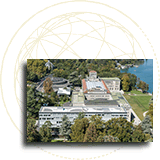UNDERSTANDING THE WTO:
THE AGREEMENTS
Overview: a navigational guide
The WTO agreements cover goods, services and intellectual property. They spell out the principles of liberalization, and the permitted exceptions. They include individual countries’ commitments to lower customs tariffs and other trade barriers, and to open and keep open services markets. They set procedures for settling disputes. They prescribe special treatment for developing countries. They require governments to make their trade policies transparent by notifying the WTO about laws in force and measures adopted, and through regular reports by the secretariat on countries’ trade policies.
These agreements are often called the WTO’s trade rules, and the WTO is often described as “rules-based”, a system based on rules. But it’s important to remember that the rules are actually agreements that governments negotiated.
This chapter focuses on the Uruguay Round agreements, which are the basis of the present WTO system. Additional work is also now underway in the WTO. This is the result of decisions taken at Ministerial Conferences, in particular the meeting in Doha, November 2001, when new negotiations and other work were launched. (More on the Doha Agenda, later.)
back to top
Six-part broad outline
The table of contents of “The Results of the Uruguay Round of Multilateral Trade Negotiations: The Legal Texts” is a daunting list of about 60 agreements, annexes, decisions and understandings. In fact, the agreements fall into a simple structure with six main parts: an umbrella agreement (the Agreement Establishing the WTO); agreements for each of the three broad areas of trade that the WTO covers (goods, services and intellectual property); dispute settlement; and reviews of governments’ trade policies.
The agreements for the two largest areas — goods and services — share a common three-part outline, even though the detail is sometimes quite different.
![]() They start with
broad principles: the General Agreement on Tariffs and Trade (GATT) (for goods), and the
General Agreement on Trade in Services (GATS). (The third area,
Trade-Related Aspects of Intellectual Property Rights (TRIPS), also falls into this category although at present it has no additional parts.)
They start with
broad principles: the General Agreement on Tariffs and Trade (GATT) (for goods), and the
General Agreement on Trade in Services (GATS). (The third area,
Trade-Related Aspects of Intellectual Property Rights (TRIPS), also falls into this category although at present it has no additional parts.)
![]() Then come
extra agreements and annexes dealing with the special requirements of specific sectors or issues.
Then come
extra agreements and annexes dealing with the special requirements of specific sectors or issues.
![]() Finally, there are the detailed and lengthy
schedules (or lists) of commitments made by individual countries allowing specific foreign products or service-providers access to their markets. For GATT, these take the form of
binding commitments on tariffs for goods in general, and combinations of tariffs and quotas for some agricultural goods. For GATS, the commitments state how much access foreign service providers are allowed for specific sectors, and they include lists of types of services where individual countries say they are not applying the
“most-favoured-nation” principle of non-discrimination.
Finally, there are the detailed and lengthy
schedules (or lists) of commitments made by individual countries allowing specific foreign products or service-providers access to their markets. For GATT, these take the form of
binding commitments on tariffs for goods in general, and combinations of tariffs and quotas for some agricultural goods. For GATS, the commitments state how much access foreign service providers are allowed for specific sectors, and they include lists of types of services where individual countries say they are not applying the
“most-favoured-nation” principle of non-discrimination.
Underpinning these are dispute settlement, which is based on the agreements and commitments, and trade policy reviews, an exercise in transparency.
Much of the Uruguay Round dealt with the first two parts: general principles and principles for specific sectors. At the same time, market access negotiations were possible for industrial goods. Once the principles had been worked out, negotiations could proceed on the commitments for sectors such as agriculture and services.
In a nutshell The basic structure of the WTO agreements: how the six main areas fit together — the umbrella WTO Agreement, goods, services, intellectual property, disputes and trade policy reviews. |
|||
Umbrella |
AGREEMENT ESTABLISHING WTO |
||
Goods |
Services |
Intellectual property |
|
Basic principles |
GATT |
GATS |
TRIPS |
Additional details |
Other goods agreements and annexes |
Services annexes |
|
Market access commitments |
Countries’ schedules of commitments |
Countries’ schedules of commitments(and MFN exemptions) |
|
Dispute settlement |
DISPUTE SETTLEMENT |
||
Transparency |
TRADE POLICY REVIEWS |
||
back to top
Additional agreements
Another group of agreements not included in the diagram is also important: the two “plurilateral” agreements not signed by all members: civil aircraft and government procurement.
back to top
Further changes on the horizon, the Doha Agenda
These agreements are not static; they are renegotiated from time to time and new agreements can be added to the package. Many are now being negotiated under the Doha Development Agenda, launched by WTO trade ministers in Doha, Qatar, in November 2001.
Share
The ‘additional details’
These agreements and annexes deal with the following specific sectors or issues:
For goods (under GATT)
· Agriculture
·
Health regulations for farm products (SPS)
·
Textiles and clothing
·
Product standards (TBT)
·
Investment measures
·
Anti-dumping measures
·
Customs valuation methods
·
Preshipment inspection
·
Rules of origin
·
Import licensing
·
Subsidies and counter-measures
·
Safeguards
For services (the GATS annexes)
· Movement of natural persons
·
Air transport
·
Financial services
·
Shipping
·
Telecommunications
